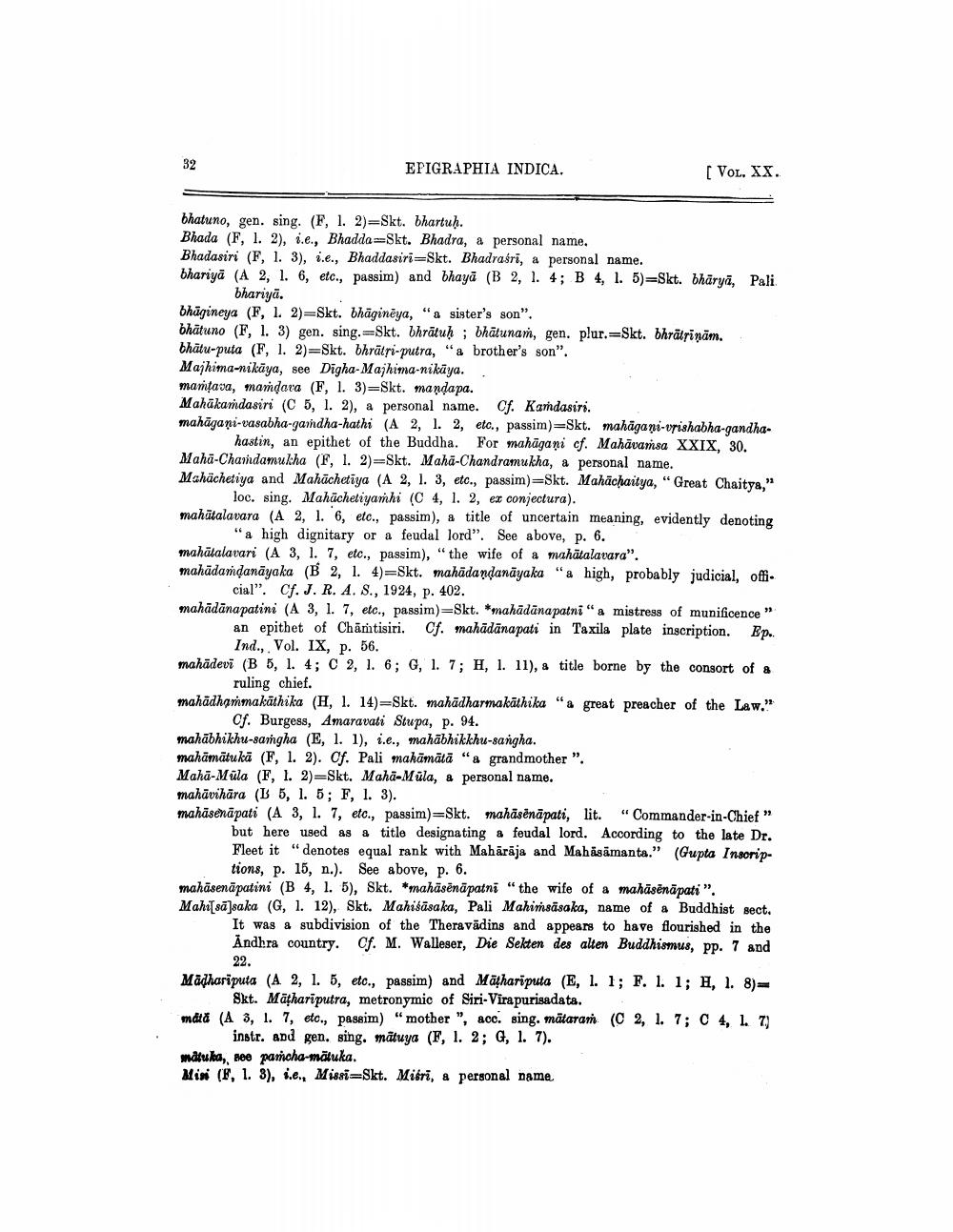________________
EPIGRAPHIA INDICA.
[Vol. XX.
bhatuno, gen. sing. (F, 1. 2)=Skt. bhartuh. Bhada (F, I. 2), i.e., Bhadda Skt. Bhadra, a personal name, Bhadasiri (F, 1. 3), i.e., Bhaddasiri=Skt. Bhadrasri, a personal name. bhariyā (A 2, l. 6, etc., passim) and bhayā (B 2, I. 4; B 4, I. 5)=Skt. bhāryā. Pali.
bhariya. bhāgineya (F, I. 2) Skt. bhāgineya, "a sister's son". bhātuno (F. 1. 3) gen. sing. Skt. bhrātuh ; bhātunam, gen. plur.=Skt. bhrätrinām. bhātu-puta (F, 1. 2)=Skt. bhrātri-putra, "a brother's son". Majhima-nikaya, see Digha-Majhima-nikaya.. mamtava, mandava (F, I. 3)=Skt. mandapa. Mahākardasiri (C5, 1. 2), a personal name. Cf. Kardasiri. mahāgani-vasabha-gandha-hathi (A 2, I. 2, etc., passim)=Skt. mahagani-upishabha-gandha
hastin, an epithet of the Buddha. For mahāgani cf. Mahāvansa XXIX, 30. Maha-Chandamukha (F, I. 2)=Skt. Mahā-Chandramukha, a personal name. Mahächetiya and Mahāchetiya (A 2, 1. 3, etc., passim)=Skt. Mahachaitya, "Great Chaitya,"
loc. sing. Mahāchetiyanhi (C 4, 1. 2, ex conjectura). mahātalavara (A 2, 1.6, etc., passim), a title of uncertain meaning, evidently denoting
"a high dignitary or a feudal lord”. See above, p. 6. mahālalavari (A 3, l. 7, etc., passim), "the wife of a mahätalavara". mahādamdanāyaka (B 2, 1. 4)=Skt. mahādandanāyaka "a high, probably judicial, offi
cial". Cf. J. R. A. S., 1924, p. 402. mahādānapatini (A 3, 1. 7, etc., passim)=Skt. *mahädäna patni" a mistress of munificence"
an epithet of Chāṁtisiri. Cf. mahādānapati in Taxila plate inscription. Ep.
Ind., Vol. IX, p. 56. mahādevi (B 5, 1. 4; C 2, 1. 6; G, 1. 7; H, 1. 11), a title borne by the consort of a
ruling chief. mahadharimakathika (1, 1. 14)=Skt. mahādharmakathika "a great preacher of the Law.”
Cf. Burgess, Amaravati Stupa, p. 94. mahābhikhu-sangha (E, 1. 1), i.e., mahābhikkhu-sangha. mahämātu kā (F, I. 2). Of. Pali mahämätä "& grandmother". Maha-Müla (F, I. 2)—Skt. Maha-Müla, a personal name. mahāvihāra (1 5, 1. 5; F, 1. 3). mahasenapati (A 3, 1. 7, etc., passim)=Skt.mahäsènäpati, lit. "Commander-in-Chief"
but here used as a title designating a feudal lord. According to the late Dr. Fleet it "denotes equal rank with Mahārāja and Mahäsämanta." (Gupta Insorip
tions, p. 15, n.). See above, p. 6. mahāsenāpatini (B 4, 1. 5), Skt. *mahäsēnāpatni "the wife of a mahāsēnāpati". Mahi[s]saka (G, 1. 12), Skt. Mahisāsaka, Pali Mahirsäsaka, name of Buddhist sect.
It was a subdivision of the Theravādins and appears to have flourished in the Andhra country. Cf. M. Walleser, Die Sekten des alten Buddhismus, pp. 7 and
22. Madhariputa (A 2, l. 5, etc., passim) and Māthariputa (E, I. 1; F. 1. 1; H, I. 8)=
Skt. Mähariputra, metronymic of Siri-Virapurisadata. mata (A 3, I. 7, etc., passim) “mother", acc. sing. mätaran (C 2, 1. 7; C 4, 1. 7)
instr. and gen. sing. matuya (F, I. 2; G, 1. 7). mdluka, see pancha-mötuka. Misi (F, 1. 3), i.e., Missi=Skt. Miéri, a personal name




